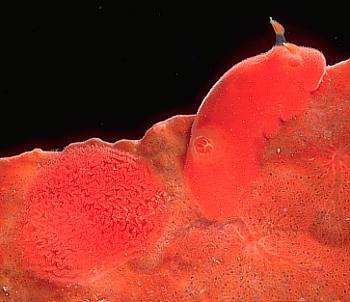
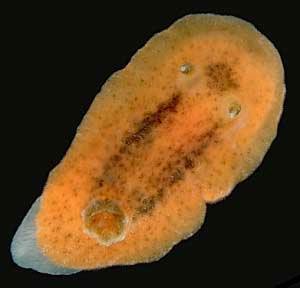
Rostanga bifurcata
Rudman & Avern, 1989
Order: NUDIBRANCHIA
Suborder: DORIDINA
Family: Dorididae
DISTRIBUTION
This species has a wide Indo-West Pacific distribution with records presented here from both the east and west coasts of Australia, Singapore, Hong Kong and Tanzania.
PHOTO
UPPER: Animal, (25mm long) with egg ribbon, on food sponge, Antho chartacea, AM C150065, Kurnell, Botany Bay, Sydney, May 1986.
LOWER: yellowish colour form, Jervis Bay, New South Wales, Australia, 18 mm long alive, AM C144049. PHOTOS: Bill Rudman.
See also R. bifurcata - Radula.
See also R. bifurcata - Anatomy.
The mantle and body are usually bright red with a close covering of red caryophyllidia. In specimens from Botany Bay, Sydney, there are variations in background colouring with some specimens having patches of brown specks on the mantle epithelium and some having white patches or irregular lines, the white pigment being on the caryophyllidia. Most specimens though are uniformly red. Other specimens from Sydney have an indistinct white reticulate pattern and specimens from southern New South Wales had a pale reddish orange background colour with a distinct pattern of brown patches. Bright red specimens from the Great Barrier Reef had irregular white streaking on the mantle while specimens from Tanzania and Hong Kong had small brown specks scattered over the mantle. In all specimens mantle glands appear to be restricted to a broad band of small white specks at the mantle edge. The rhinophore stalk is translucent clear and the club is usually the same colour as the mantle but with the upper third being white or having white patching. There is usually some brown dusting on the rhinophore lamellae. The gills are a translucent red matching the background colour of the mantle. The main blood vessel on the inside face of each gill is often white, or has some white dusting clearly outlining the branching on the gill.
The body is similar in shape to R. arbutus but the spicules forming a subterminal ring in the caryophillidia are not as prominent as in that species. The rhinophores are relatively long and the club tapers to a slender stalked knob at the tip. The rhinophore lamellae lie almost horizontally but slope downwards posteriorly. There are seven to ten gills arranged in an upright circle around the anal papilla. The gills are tripinnate but each pinnule and its secondary branches are shaped so that each gill has a very regular outline with a low rounded tip.
The egg ribbon has only been observed for New South Wales specimens. It consists of large multi-spiralled ribbon of microscopic red eggs. The ribbon is thrown into tight folds along its free end. From personal observations and those of Hunter & Woodward (personal communication) development is planktotrophic, possibly lecithotrophic, small swimming veligers hatching from the egg mass nine days after deposition.
Sublittoral specimens from Sydney Harbour and Botany Bay are only found on a large erect plate-like poecilosclerid sponge Antho (Isopenectya) chartacea (Whitelegge, 1907) (Family Microcionidae). They feed and lay their egg masses on this sponge. However, as this sponge is not found intertidally it is probable that intertidal specimens feed on other species of sponge. As this is the first record of Antho chartacea since its original description from Sydney Harbour, we do not know whether it is present throughout the range of R. bifurcata.
Reference:
• Rudman, W.B., Avern, G. (1989) The genus Rostanga (Nudibranchia: Dorididae) in the Indo-West Pacific. Zoological Journal of the Linnean Society 96(3): 281-338.
Rudman, W.B., 2002 (February 5) Rostanga bifurcata Rudman & Avern, 1989. [In] Sea Slug Forum. Australian Museum, Sydney. Available from http://www.seaslugforum.net/find/rostbifu
Related messages
Rostanga from New Caledonia
August 31, 2006
From: Jean-François Hervé
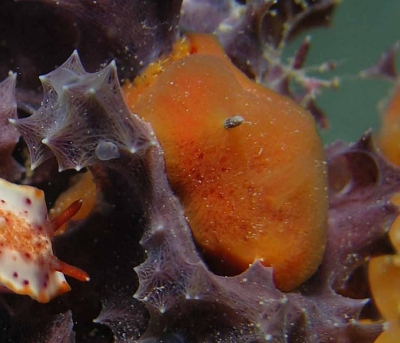
Dear Dr Rudman,
Thank you for your answer [message #17621] concerning the Hypselodoris. Here are some more photos of the orange thing which you think may be a dorid. I didn't realise it was a dorid when I photographed it - perhaps I wasn't awake! I guess it was about the same length as the Hypselodoris
Locality: Noumea, 10 m, New caledonia, Pacific Ocean, July 2006. Length: approx 15 mm. Photographer: Jean-François Hervé
Thank You very much.
Jean-François Hervé
http://jfherve.free.fr/nudibranches/
jfherve@free.fr
Hervé, J-F, 2006 (Aug 31) Rostanga from New Caledonia. [Message in] Sea Slug Forum. Australian Museum, Sydney. Available from http://www.seaslugforum.net/find/17622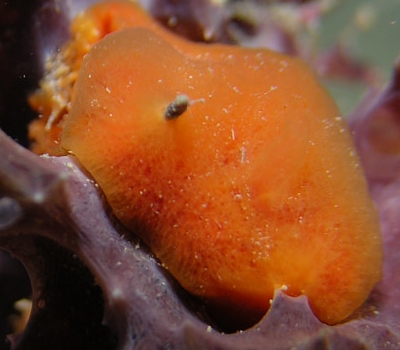
Dear Jean-François,
When I first saw it in your earlier photo on the purple sponge I was pretty sure it was a species of Rostanga, but I was puzzled at it being on the purple sponge which is not the type of sponge that species of Rostanga feed on. I can see in these new photos however that there is also an orange sponge, of the same colour as the Rostanga, mixed up with the purple colony. For some reason, it only has one [brown] rhinophore visible.
Most species of Rostanga are orange or red with a spiculate texture caused by the close packed caryophyllidia. External differences can be found in the shape of the rhinophores and in biological characteristics such as nature of egg mass, size of eggs, and food sponge. Internally, radular morphology is the most useful character. Because a photo like this doesn't really give me enough information to identify your animal to species, I can't be 100% sure of its name. However I have found Rostanga bifurcata in New Caledonia before, and the shape and the colour of the rhinophores are the same, so I will tentatively identfy it as that species.
Best wishes,
Bill Rudman
Rostanga bifurcata from Hong Kong
February 8, 2002
From: Bill Rudman & Brian Darvell
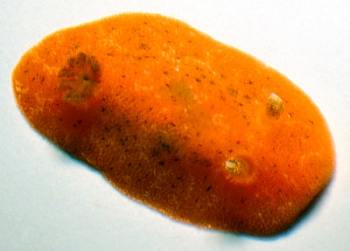
Here is some information and photos on Rostanga bifurcata from Brian Darvell's Hong Kong collections.
PHOTO:
Pak Ma Tsui; 7 m, one specimen (10 mm long preserved), 21 April 1984, AM C142191. Photo: Brian Darvell.
Hong Kong Collection Records:
(1) Kai Kung Chan, Kat O; 5-10m, one specimen (6 mm long preserved), 15 April 1983, AM C139195. (2) W. side of Kong Chan, Mirs Bay; 4 m, one specimen (8 mm long preserved), 18 April 1983, AM C139214. (3) Kiu Tsui Chan (W); 4 m two specimens (6, 7 mm long preserved), 31 March 1984, AM C142190. (4) Pak Ma Tsui; 7 m, one specimen (10 mm long preserved), 21 April 1984, AM C142191.
Reference:
• Rudman, W.B. & Avern, G.J. (1989). The genus Rostanga Bergh, 1879 (Nudibranchia: Dorididae) in the Indo-West Pacific. Zoological Journal of the Linnean Society 96: 281-338.
Best wishes,
Bill Rudman & Brian Darvell
Rostanga bifurcata from Coffs Harbour
February 8, 2002
From: Bill Rudman
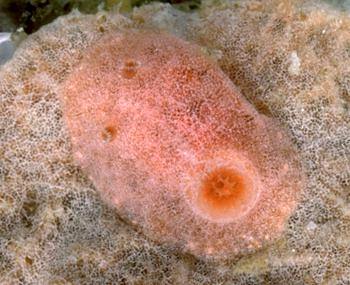
To show a bit more variation in Rostanga bifurcata here are a couple more animals from northern New South Wales, Australia. The egg ribbon is only a poor attempt in a glass dish after collecton but it shows the size of the eggs and the wavy and crenulate edge of the egg ribbon which is characteristic of this species [see photo of full egg ribbon]. Both animals are photographed on the sponges they were found on and both have a remarkable resemblance to these sponges in colour and texture. In this species, like most species of Rostanga, individual animals show a close resemblance to their food sponge. This means that colour can vary within a species quite considerably if the sponge they feed on is itself variable in colour, or if the species feeds on a number of species of sponge.
UPPER RIGHT: Pig Island, Coffs Harbour, NSW. Dec 1990, 20-22m. 11mm long alive. AM C164619
LOWER PHOTOS: Split Solitary Id, Coffs Harbour, NSW. December 1990. egg ribbon and animals. AM C164564 18, 22mm long alive. PHOTOS: Bill Rudman.
Best wishes,
Bill Rudman


Rostanga at Fly Point
January 9, 1998
From: David & Leanne Atkinson
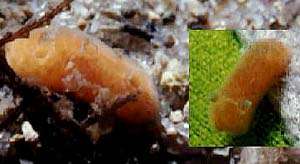
Bill,
We found this at Fly Point, Port Stephens, New South Wales over Christmas.
Thanks,
David & Leanne Atkinson.
atkin@hunterlink.net.au
Atkinson, D. & L., 1998 (Jan 9) Rostanga at Fly Point. [Message in] Sea Slug Forum. Australian Museum, Sydney. Available from http://www.seaslugforum.net/find/123This is probably Rostanga bifurcata. Most species of the dorid genus Rostanga are orange or red, and apparently take up colour pigments from their sponge food so that their colour exactly matches the sponge they are feeding on. There are a number of species of Rostanga in south eastern Australia and they are difficult to separate externally. Differences in the shape of their rhinophores and gills can be useful but often they cannot be identified correctly until they are dissected and their radular teeth are studied with an electron microscope. One very good character is the shape of the egg ribbon, every species so far looked at has a distinctly differently shaped ribbon... Bill Rudman
Rudman, W.B., 1998 (Jan 9). Comment on Rostanga at Fly Point by David & Leanne Atkinson. [Message in] Sea Slug Forum. Australian Museum, Sydney. Available from http://www.seaslugforum.net/find/123